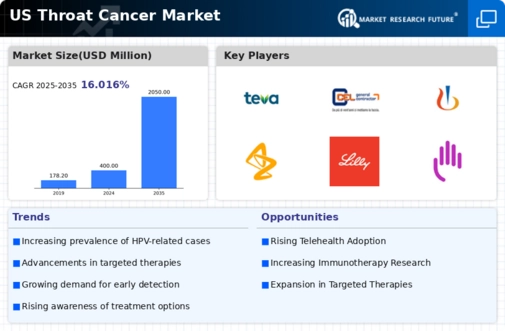Rising Incidence Rates
The throat cancer market is witnessing a significant rise in incidence rates., particularly among certain demographics. Data indicates that the incidence of oropharyngeal cancers, a subset of throat cancer, has risen by approximately 2.5% annually in the US. This trend is largely attributed to the increasing prevalence of human papillomavirus (HPV) infections, which are linked to throat cancer. As awareness of HPV's role in throat cancer grows, more individuals are seeking screening and preventive measures. Consequently, this rising incidence is driving demand for innovative treatment options and diagnostic tools within the throat cancer market. The healthcare industry is responding by investing in research and development, which is likely to enhance treatment modalities and improve patient outcomes.
Government Initiatives and Funding
Government initiatives aimed at cancer prevention and treatment are playing a pivotal role in shaping the throat cancer market. The US government has allocated substantial funding for cancer research, with the National Cancer Institute (NCI) investing over $5 billion annually in various cancer-related projects. These initiatives not only support research into new therapies but also promote public awareness campaigns about throat cancer risk factors and prevention strategies. As a result, increased funding is likely to facilitate the development of novel treatment options and improve access to care for patients. This proactive approach by government entities is expected to bolster the throat cancer market, fostering innovation and enhancing patient outcomes.
Growing Demand for Targeted Therapies
The throat cancer market is witnessing a shift towards targeted therapies, which are designed to specifically attack cancer cells while minimizing damage to healthy tissue. This trend is driven by the increasing understanding of the molecular mechanisms underlying throat cancer. As a result, pharmaceutical companies are investing heavily in the development of targeted therapies, which are projected to capture a significant share of the market. For instance, the market for targeted therapies in throat cancer is expected to grow at a CAGR of 8% over the next five years. This growing demand reflects a broader trend in oncology towards more personalized treatment approaches, which are likely to improve patient outcomes and quality of life.
Increased Patient Advocacy and Support
The throat cancer market is benefiting from a surge in patient advocacy and support organizations that are raising awareness and providing resources for patients and families affected by throat cancer. These organizations play a crucial role in educating the public about the symptoms, risk factors, and treatment options available. As advocacy efforts intensify, more individuals are likely to seek medical attention earlier, which can lead to improved prognosis and survival rates. Additionally, these organizations often collaborate with healthcare providers to promote clinical trials and new treatment options, thereby driving innovation within the throat cancer market. The growing presence of patient advocacy groups is expected to enhance the overall landscape of care for throat cancer patients.
Technological Innovations in Diagnostics
Technological advancements in diagnostic tools are significantly impacting the throat cancer market. Innovations such as liquid biopsy and advanced imaging techniques are enhancing early detection rates, which is crucial for improving survival outcomes. For instance, the introduction of next-generation sequencing (NGS) has enabled more precise identification of genetic mutations associated with throat cancer. This shift towards personalized medicine is likely to drive growth in the throat cancer market, as healthcare providers increasingly adopt these technologies. Furthermore, the integration of artificial intelligence in diagnostic processes is expected to streamline workflows and reduce time to diagnosis, thereby potentially increasing patient throughput and treatment initiation.

















Leave a Comment